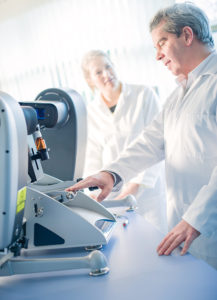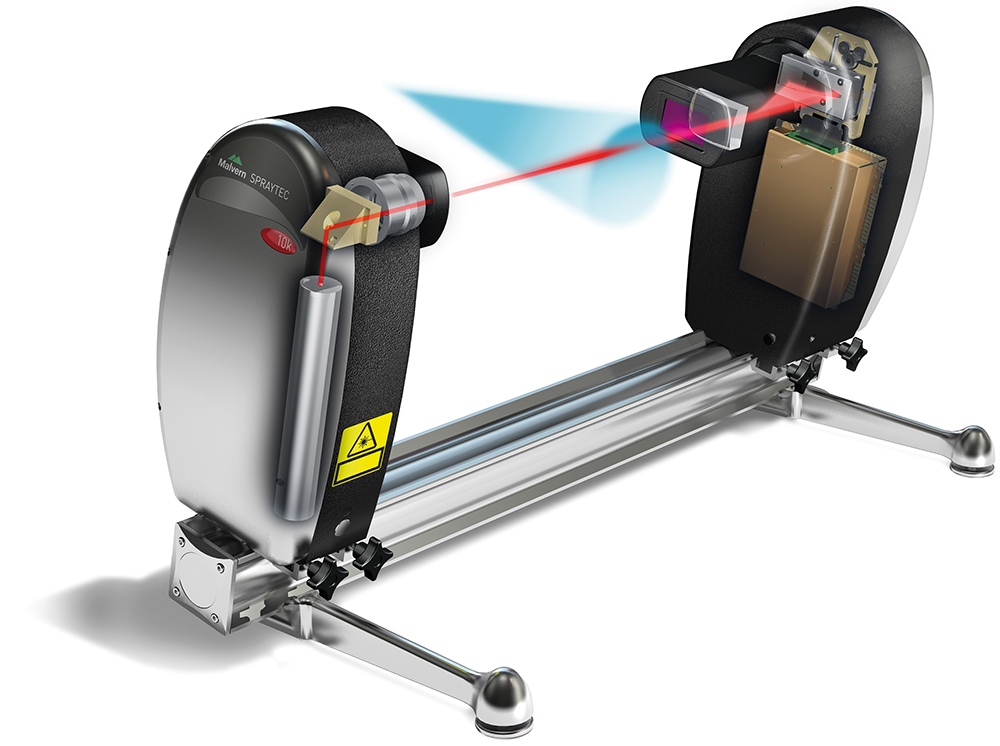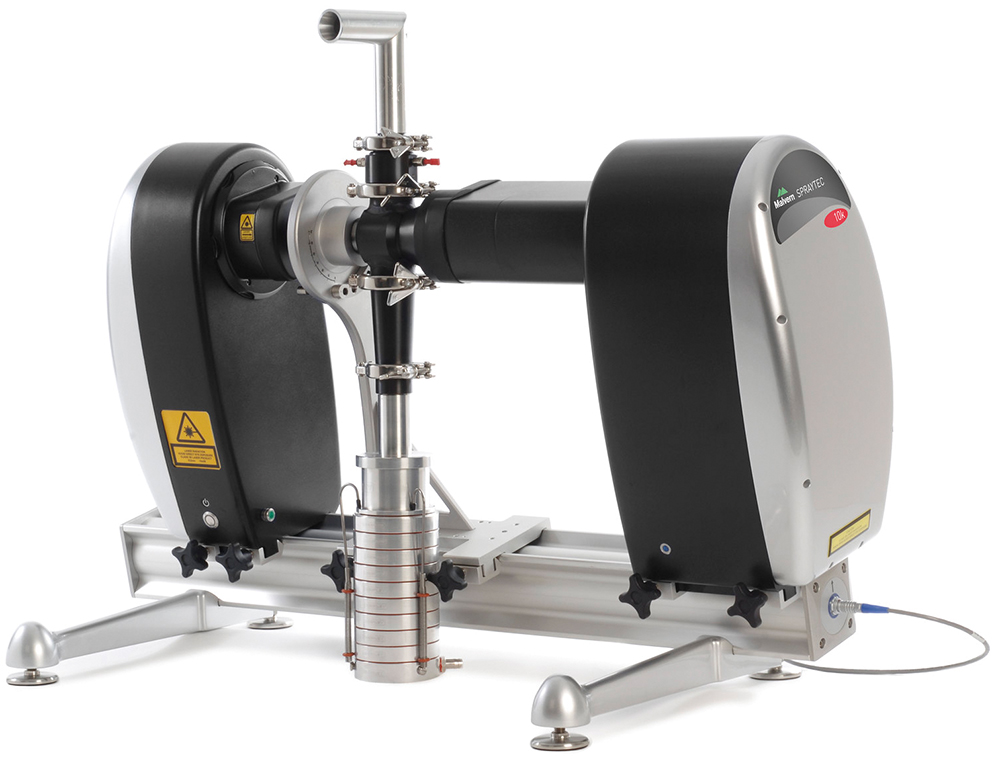Citation: Virden A, “Spraytec Laser Diffraction System: Robust, Reproducible Droplet Size Data”. ONdrugDelivery, Issue 154 (Nov 2023), pp 48–50.
Anne Virden discusses the benefits and applications of Malvern Panalytical‘s Spraytec laser diffraction system for the measurement of spray particles and droplets.
Controlling the size of spray particles and droplets is critical for the effective delivery of medication via drug delivery devices such as nasal sprays and inhalers. As they are influenced by interactions between the formulation and the delivery device, a detailed understanding of the impact of both of these elements is essential for successful product development and commercialisation.
“FDA guidance recommends the use of laser diffraction for droplet size measurement.”
Nasal spray formulations, for example, usually consist of an API that is dissolved or suspended in an aqueous solution. Typically, nasal sprays destined for deposition in the nasopharyngeal region – such as common cold and influenza remedies – will be designed to deliver a droplet size of 20–120 μm. Particles below the lower limit are susceptible to inhalation into the lungs, while those that are too large tend to remain in the front of the nose or are lost through dripping. Droplet size is therefore a critical quality attribute (CQA) for nasal sprays.
The droplet size delivered by a nasal spray is a function of the physical properties of a formulation, most notably its viscosity, as well as the mechanism and geometry of the nasal spray pump. Key characteristics of a pump include the applied actuation profile, the pre-compression ratio and the length, geometry and orifice size of the actuator. Together, these determine the shear force applied to the formulation during actuation and, as a result, the size of the droplets delivered.
By manipulating device and formulation variables, product developers can tune nasal spray systems to deliver the required droplet size. Therefore, both the parameters of the pump and the physical properties of the formulation, such as viscosity, are critical material attributes (CMAs) – variables that have a direct impact on the droplet size CQA, which must be controlled to ensure the bioequivalence of a generic nasal spray.
Suspension nasal sprays bring a further level of complexity, as both the size of the droplets produced by the nasal spray and the size of the suspended API must be considered. The API particles are potentially vulnerable to changes in morphology during the actuation process, and such changes may, in turn, affect bioavailability.
The API particle size is therefore another CMA that must be considered as part of the demonstration of bioequivalence, with the US FDA’s guidance suggesting measurements pre- and post-actuation. API particle size pre- and post-actuation can be measured using a combination of analytical imaging and Raman spectroscopy with Malvern Panalytical’s Morphologi 4-ID.

Figure 1: Spraytec laser diffraction system with nasal spray support and actuator.
SPRAYTEC LASER DIFFRACTION SYSTEM
FDA guidance recommends the use of laser diffraction for droplet size measurement. This is the technique used by Malvern Panalytical’s Spraytec measurement system (Figure 1), which has been specifically designed to address the unique requirements for spray characterisation and deliver robust, reproducible droplet size data.
Incorporating more than 35 years of experience in spray characterisation applications, the Spraytec laser diffraction system provides the data required to fully understand spray and atomisation processes. It can:
- Measure across a wide size range (0.1–2000 μm) using just two lenses
- Resolve rapid changes in droplet size over time, by taking up to 10,000 measurements a second
- Deliver accurate, concentration-independent results using a patented multiple scattering analysis
- Characterise wide spray plumes without risking optical contamination
- Simply reveal the dynamic changes in spray particle size through its unique size history analysis software.
The Spraytec system measures the intensity of light scattered as a laser beam passes through a spray. This data is then analysed to calculate the size of the droplets that created the scattering pattern. The system is made up of the following main elements (Figure 2):
- A transmitter module that contains the collimated laser light source used to illuminate the spray during a measurement.
- A receiver module that can hold one of two lenses (300 mm or 750 mm) that focus any light scattered by the spray onto a series of detectors. These detectors accurately measure the intensity of light scattered by the spray droplets over a wide range of angles.
- An optical bench that ensures that the transmitter and receiver are aligned. The length of this can be changed to fit various applications, with the longest bench being 2.5 m long.
- The Spraytec software that controls the system during the measurement process and analyses the scattering data to calculate spray size distributions. The results are displayed as a “size history” trend plot, allowing any changes in the droplet size over time to be recognised instantly.

Figure 2: Spraytec cutaway showing configuration of optical components.
“The Spraytec laser diffraction system provides the data required to fully understand spray and atomisation processes.”
SPRAYTEC APPLICATIONS
The flexibility of the Spraytec system makes it suitable for a wide range of applications, from fundamental research and development through to product quality control and batch release testing. It delivers accurate, reproducible spray size analysis in an easy-to-understand format – improving product understanding and control.
For orally inhaled and nasal drug products, for example, the Spraytec system can chart the changes in spray particle size produced during single device actuations – allowing the dynamics of particle dispersion to be identified, along with the device reproducibility. As such, formulations can be rapidly screened for the correct spray properties – reducing development times and improving drug delivery efficacy.
PULMATRIX CASE STUDY
Pulmatrix turned to laser diffraction when it was developing its novel iSPERSE inhaled dry powder delivery platform for use in the pulmonary delivery of drugs for local or system applications. The powders involved are characterised by small particle size, relatively high density and flow-rate-independent dispersibility, along with the ability for low or high drug loading of single or multiple drugs. The platform’s properties yield drug delivery capabilities not feasible with conventional dry powder technologies, which rely on the use of lactose blending or low-density, porous particles.
iSPERSE uses proprietary formulations to create a robust and flexible platform that can accommodate low or high drug loads of a range of molecule types. The Spraytec with inhalation cell (Figure 3) is used to aid understanding of the dispersion properties of potential new formulations by measuring the dispersed particle size over a range of different flow rates. Quickly assessing the dispersibility by laser diffraction speeds up development times.

Figure 3: Spraytec laser diffraction system with inhalation cell.
The particles are routinely prepared from aqueous or organic systems in a single-step spray-drying process. The powders can be formulated to contain as little as 5% excipients, in contrast to lactose-blend dry powders that typically consist of over 80–90% lactose and therefore only contain small amounts of drug. This fundamental formulation difference, along with the powder property of relatively high density, maps directly into the drug dose, creating feasible drug doses in a unit of up to 100 mg for iSPERSE.
Previous article
INTERVIEW: RDD EUROPE 2023 REVIEW & RDD 2024 PREVIEWNext article
PERFECT TIMING FOR THE AUTOMATION OF OINDP TESTING
